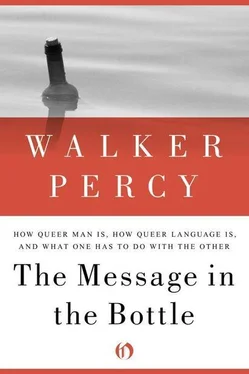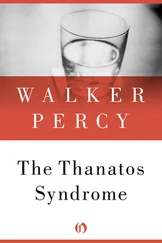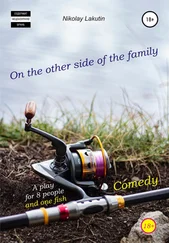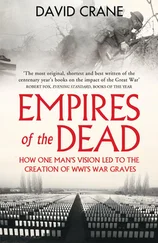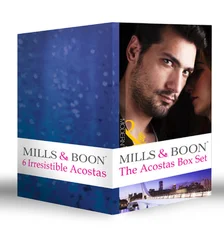The second stage of language acquisition is characterized by two-word utterances, usually described as “pivot-open” constructions. The pivot class has fewer members than the open class. Thus, a child will say my sock, my boat, my fan, or big plane, big shoe, big sock, etc. (Braine); that knee, that coffee, that Adam, or two coat, two stool, two Tinkertoy, etc. (Brown and Bellugi); this arm, this baby, this yellow, or the other, the pretty, the dolly’s, or here baby, here yellow, etc. (Ervin). The following rule therefore holds for both single-word utterances and pivot-open combinations (McNeill):
S→ (P) + O
which would account in a purely descriptive manner for such utterances as ball or my ball or here ball or there yellow or there drop, whatever syntactical or sentential differences may exist.
It has been noted that members of the pivot class are usually functors (a, that, the, here) but not always (pretty, big), while open-class words are nearly always contentives (boy, coffee, sock, knee, wet, yellow).
The third stage is characterized by two developments:
(1) Differentiation of the pivot class.
For example, car, through successive expansions a car, that a car, that a big car, eventually reaches its adult form that is a big car (see Brown and Bellugi; McNeill). Descriptive rules can be inferred:
NP → (P) + N car, a car
NP 1→ Dem + Art + M + N that a my car
NP 2→ Art + M + N a big car
NP 3 → Dem + M + N that big car
NP 4 → Art + N the car
NP 5→ M + N my car
NP 6→ Dem + N that car
These rules allow, for example, that a big horsie but not a big that horsie.
(2) The open-open construction.
Instead of saying here man, here car, here coffee or a bridge, a man, a daddy, the child begins to combine two words of the open class: man car (a man is in the car), car bridge (the car is under the bridge), coffee Daddy (here is coffee for Daddy), etc. (Braine).
These open-open constructions are often uttered in strong contextual situations, for example, where mother and child are looking at the same thing. The mother, in other words, is a reliable interpreter. Indeed, the mother actually repeats and expands the child’s utterance, keeping the order of the contentives but adding functors and inflections, as much as to say, “Isn’t this what you mean?” Some examples of open-open combinations with the mother’s “interpretations” and expansion and, presumably, the child’s approval (from Brown and Bellugi):
Child Mother Baby high chair Baby is in the high chair Mommy eggnog Mommy had her eggnog Eve lunch Eve is having her lunch Mommy sandwich Mommy’ll have a sandwich
Note one consequence of the transition from the pivot-open to the open-open construction. The child’s discovery of the latter makes possible an almost exponential increase in the number even of two-word utterances — a fact of the highest significance in any attempt to account for that unique characteristic of the Language Acquisition Device: the ability to utter and understand any number of new sentences. The number of two-word combinations noted by Braine in one child observed at regular intervals went so: 14, 24, 54, 89, 350, 1400, 2500 + (Braine).
Such then is a too-brief and much-oversimplified summary of the highlights of language acquisition as it is actually observed to occur in children.
Judged by the criterion of adult NP-VP syntax, child’s speech appears somewhat fragmentary and vagarious, an assortment of one-word utterances, phrases, fragments, “pivot-open” and “open-open” combinations, the whole odd lot accounted for by purely descriptive “generative phrase rules.”
The real issue seems to be whether the utterances of children, or of anyone at all for that matter, can be understood by a textual analysis which abstracts from the behavior of people who utter sounds to each other about one thing or another. What if sentences have components other than lexical items? If this is so, then a theory of the ontogenesis of language deriving exclusively from the study of corpora of speech must necessarily issue in a purely descriptive structuralism or a formal deductive calculus which transforms one kind of sentence to another by “rules” which, as matters stand now, cannot even in principle be correlated with anything that happens inside people’s heads.
One wonders therefore: How might the development of child’s speech appear when viewed by a transsyntactical theory of sentences, which sees the conventional NP-VP construction as a subclass of the class of all sentences?
I think it can be shown that if the speech of children is viewed not merely as a corpus from which certain descriptive grammatical rules can be inferred but as a behavior which implicates both syntactical and “nonsyntactical” elements, it is possible to arrive at more general semiotic rules of sentence formation. The various descriptive rules of “phrase formation” will then be seen to be coherent stages in the emergence of sentence utterances.
(1) The “one-word utterance,” so characteristic of the first stage of language acquisition, is nothing more Or less than the earliest appearance of the naming sentence, a complete sentence in semiotic terms albeit lacking some later syntactical and functional elements.
The rule involved is not a phrase rule, such as
NP → N
(Brown and Bellugi)
where NP is “noun phrase” and N a “noun,” or a rule for “pivot-open” combinations
( P ) + O
but rather the general behavioral rule of formation of the naming sentence
S→ ( I ) ( E c) (is) S c
where I , the index, is in this case an item of behavior (e.g., a pointing at or looking at), E c is the thing or quality or action experienced by the child and indicated as one of a class of such experiences, (is) is the copula dispensed with until the final adult form, S c is the contentive word, usually a sound — e.g., noun ball, adjective yellow, verb hop —uttered as a member of a class of such words. (As Charles Peirce would say, a contentive word or symbol is not a single thing but a kind of thing [Peirce]).
(2) A descriptive rule for the formation of pivot-open constructions has been given as
S → P + O (e.g., a knee, a man, a Mommy [McNeill])
A more general rule, which allows for the expansion and differentiation of the pivot class, is given by Brown as a rule for generating noun phrases:
NP → (Dem) + (Art) + (M) + N
This rule accommodates not only one-word utterances, car, boat, yellow, and pivot-open constructions, my car, my boat, my yellow, but also such “phrases” as that a car, that a my car, etc.
What needs to be noted, however, is that none of these expressions is a phrase, save only in that sense decreed by a purely syntactical definition of sentences. Rather, all are complete semiotic sentences as provided by the general rule for naming sentences (1). Where this rule differs from Brown’s descriptive phrase rule is in its specifying (a) that what is formed is not a phrase but a sentence, (b) that the index I is a general semiotic class of which Brown’s demonstratives (that, there) belong to the syntactical subclass, (c) that the copula is added because the final adult form requires it.
Читать дальше
